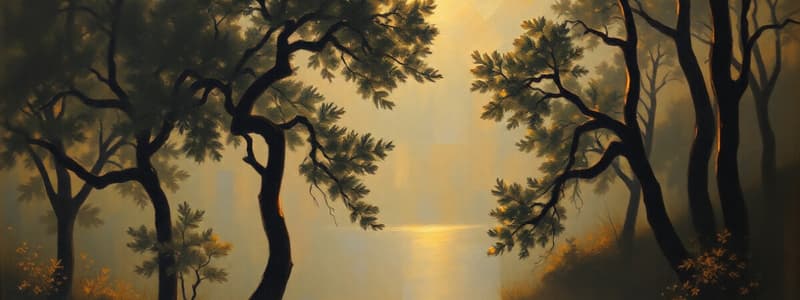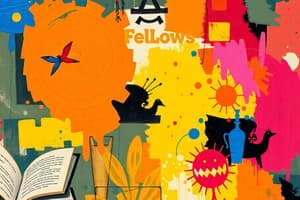Podcast
Questions and Answers
Which of the following is NOT one of the four major genres of literature mentioned in the content?
Which of the following is NOT one of the four major genres of literature mentioned in the content?
- Drama
- Poetry
- Fantasy (correct)
- Fiction
What is the French word for "genre"?
What is the French word for "genre"?
- Zhan-re
- Zahn-ruh (correct)
- Zahn-re
- Zhan-ruh
Based on the puzzle, which of the following literary genres is most closely associated with "Imagination"?
Based on the puzzle, which of the following literary genres is most closely associated with "Imagination"?
- Nonfiction
- Fiction (correct)
- Poetry
- Drama
What is the primary purpose of identifying different literary genres?
What is the primary purpose of identifying different literary genres?
Which of the following best describes the relationship between the puzzle and the content?
Which of the following best describes the relationship between the puzzle and the content?
Flashcards
Literary Genre
Literary Genre
A category of literature based on similarities in form, style, or subject matter.
Major Genres
Major Genres
The four primary categories of literature: fiction, poetry, drama, and non-fiction.
Fiction
Fiction
Literature created from the imagination, not based solely on fact.
Poetry
Poetry
Signup and view all the flashcards
Drama
Drama
Signup and view all the flashcards
Study Notes
21st Century Literature
- Explores literature from the Philippines and worldwide.
- Focuses on genres and various forms of contemporary literature.
Genres
- Genre is a style or type of literary work.
- It's a way to classify and organize literary works into categories.
- Major categories include poetry, drama, fiction, and nonfiction.
- Works are categorized based on form, content, and style.
Literary Pool (Word Search)
- The word search puzzle lists four major literary genres.
What is Literary Genres?
- Genre is the grouping of literary works into categories like poetry, drama, fiction, and nonfiction.
- Categorization is based on form, content, and style.
The Four Conventional Literary Genres
- These are the categories typically used in defining literature.
- Included in the categories studied are:
- Poetry
- Drama
- Fiction
- Nonfiction
Poetry
- Poetry is an imaginative awareness of experience expressed through meaning, sound, and rhythmic language.
- It evokes emotional responses.
- It's an authentic and individual mode of expression.
Drama
- Drama is a composition in prose or verse that demonstrates conflict and is performed on a stage.
- Drama is presented through dialogue or pantomime.
Fiction
- Fiction is creative literature based on imagination, even if based on a true story.
- Examples of fiction include novels, short stories, and novellas.
Nonfiction
- Nonfiction is based on facts and the author's opinion about a subject.
- It aims to inform and sometimes persuade.
- Examples include biographies and articles from printed media.
Modern Literary Genres Used by 21st-Century Writers
- The study examines modern literary genres.
Comic Books
- Comic books are excerpts from larger serialized narratives.
- Told visually through illustrations and panels.
- Famous publishers include Archie Comics, Marvel Comics, and DC Comics.
Graphic Novel
- Graphic novels are narratives in comic book format.
- Share characteristics of traditional novels, having a clear beginning, middle, and end, along with character development.
Comic Books vs. Graphic Novels
- Comic books are published more frequently (weekly or monthly).
- Graphic novels cover a wide range of genres and subject matters.
Picture Book
- Picture books are for children, where illustrations are as crucial as the words in telling the story.
- Typically, they are 32 pages long.
Illustrated Novel
- An illustrated novel is an extended narrative with accompanying images that enhance the meaning.
Digi-Fiction
- Digi-fiction combines book, movie/video, and internet website to present the full story.
- Students need to navigate, read, and view these to understand the narrative.
Manga
- Manga is a Japanese word for comics.
- Some are adapted into animated series or movies.
- Stories are read right-to-left and top-to-bottom.
Shonen, Shojo, Seinen, Josei, Kodomo
- These are categories of manga/anime sorted by target audience (shonen, shojo, seinen, josei, and kodomo—boys, girls, adults, women, children, respectively).
Doodle Fiction
- The author integrates doodle writing and drawings, often adding humorous elements to the story.
Text-Talk Novels
- These novels use dialogue to portray social media exchanges, often presented via screenshots.
Flash Fiction
- Flash fiction are very short stories, usually a few hundred words.
- Often called micro-fiction or sudden fiction
Six-Word Story
- Six-word stories are the shortest stories possible, containing only six words, yet telling a story.
Chick Lit
- Chick lit is genre fiction focusing on humorous and lighthearted issues of modern womanhood.
- Typically features a female protagonist whose feminine traits significantly highlight the plot.
Creative Non-Fiction
- Creative nonfiction focuses on narrative and is different from technical writing, but uses factual information.
Science Fiction (Sci-Fi)
- Science fiction (Sci-Fi) features imaginative concepts such as futuristic technology, space travel, time travel, or parallel universes and extraterrestrial life.
Web Blogs
- Weblogs (blogs) contain short articles; these "posts" are regularly updated.
- Blogs can be written by one person or multiple authors with their unique perspectives and experiences.
Hyper Poetry
- Hyper poetry is a form of digital poetry that uses hypertext links.
- The words, phrases, or even lines can appear in a varied order or be dynamically changed.
Studying That Suits You
Use AI to generate personalized quizzes and flashcards to suit your learning preferences.




